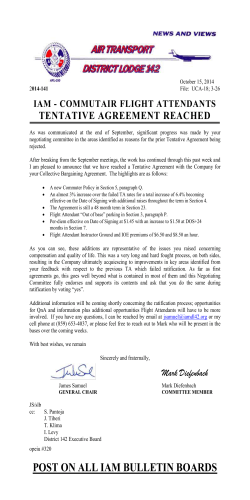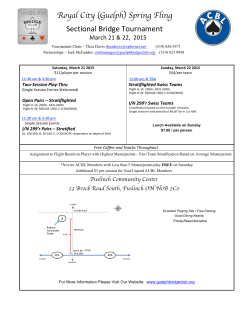
Aerospace Electronics and Systems
Council of Scientific and Industrial Research NATIONAL AEROSPACE LABORATORIES Bangalore, India Aerospace Electronics and Systems Symbology Evaluation Facility Salient features: ■ ■ ■ ■ ■ ■ ■ ■ ■ ■ ■ ■ ■ Developed using VAPS and SCADE tools Symbologies designed as per ARP 4102 Simulation can be done with stored flight data or from the real Avionics instruments Configurable displays Cursor control device interface High Speed data communication between application and server 15.1 inches diagonal displays Single Mouse controlled for all the displays Wide screen 15” displays Industrial AMLCD sun light readable displays Pilot in Loop Simulation interface ready Pilot Symbology evaluation platform Short Symbology Turn-around time of one hour Integrated Global Bus Avionics Processing System Salient features: ■ ■ ■ ■ ■ ■ ■ ■ ■ ■ ■ ■ Integrated Modular Avionics based architecture ARINC 653 based time & memory partitioning Dual Processing node with hot standby feature Dual redundant ARINC 664 communication Support upto five ARINC 818 based display Support Weather radar data (ARINC 708) and RAW camera input ( RS170A) Supports multiple application simultaneous execution without affecting the safety Dual redundant VPX based backplane Reconfigurable I/O system Dual hot standby power distribution modules State of the art thermal management scheme ARINC615A compliant data loading scheme Digital Autopilot Expertise developed for the Limited authority three axis flight control system for SARAS is a closed loop control system. The system is designed on a Modular Avionics Unit which hosts the application software and DEOS operating system. Established Independent Verification and Validation activities as per RTCA DO 178B level A for: ■ Verifying and validating the registries for configurable modular architecture, configurable gain tuning parameters, and flight test parameters ■ Object code verification ■ Establishment of build procedures and IV&V metrics Vision System Technologies for MAV Research in the area of vision for unmanned aerial vehicles (UVAs) is conducted at the Signal Processing and Systems Group of the Division. The activities are intended to support improvements in flight controls and usability of the UAV for its primary tasks, such as surveillance, while maintaining the low weight and power requirements to allow the UAV to be small and inexpensive with relatively long flight times. applies its diverse engineering expertise and facilities to address challenges in autonomous system technologies such as Image processing, Sensor fusion, Embedded computing, Navigation, Path planning, Command and control in building applications such as ■ First Person Viewing Systems ■ Vehicle Recovery Systems ■ Vision Based Enhanced Autopilots Autopilot Hardware for MAV Parameter Description Range Processor ARM CortexM3 CPU core 32 - Bits Clock Operating Frequency 24 MHz ROM Programmable memory 256 Kbytes I2C Interface Internal interface (2) 100/400 Kbps UART Interface Serial Communication (1) 9.6/57.6 Kbps SPI Interface 6- pin connector >1 Mbps USB Mini USB PWM Control signal 7- pin connector Sensors 3 Axes Gyro, Accelerometer, (3) (1) (8) Magnetometer + Static Pressure 1.5 - 480Mbps 3.3 V Active ActiveNoise NoiseControl ControlSystem System(ANC) (ANC)for forHelmet Helmet ANC ANC for for helmet helmet isis the the state state of of the the art art system system designed designed && developed developed to to reduce reduce the the fifighter ghter aircraft aircraft noise noise inside inside the the helmet. helmet.This This DSP DSP based based adaptive adaptive system system reduces reduces noise noise without without interfering interfering with with the the voice voice communication communication signals. signals. Salient Salientfeatures: features: ■■ Noise Noisereduction reductionof ofabout about14dB 14dB ■■ Frequency Frequencyrange range80Hz 80Hz––2000Hz 2000Hz ■■ Battery Batteryoperated operatedwith with44hrs. hrs.backup backup ■■ Inbuilt Inbuilt recorder recorder for for off off-line -line data data analysis analysis and and pilot pilotcommunication communicationanalysis analysis ■■ Easy Easyto touse usemicro microswitch switchon oncable cable ■■ Generic Generic design design enables enables the the system system to to be be integrated integratedwith withany anyaircraft aircrafthelmet helmet ■■ Dimensions Dimensions 120mm 120mmXX90mm 90mmXX25mm 25mm ■■ Weight Weight350g 350g Display DisplaySystem SystemEICAS EICASand andPFD PFD Salient Salientfeatures: features: ■■ 88XX66inches inchessmart smartdisplay display ■■ Application Application swap swap mechanism mechanism through through single single button buttonpress press Atom AtomBased BasedProcessor Processor 22 22 channels channels of of ARINC ARINC 429 429 Multi Multiwindow windowdisplay displaypages pages DO DO160G 160Gproven provenqualifi qualified edhardware hardware DO DO178B 178BLevel LevelAAapplication application Do Do254 254Level LevelAAhardware hardwarecertifi certification cation digital digital interface interface ■■ DO DO178 178Level LevelAAapplication applicationsoftware software ■■ FAA FAAcertifi certified edHardware Hardware ■■ Quad Quadredundant redundantdisplays displays ■■ Cross Crosscommunication communicationbetween betweendisplays displays ■■ Auto Autoreversion reversionfeature featureto tocritical criticalfailures failures ■■ Confi Configurable gurableapplication applicationfor fordiff different erentaircraft aircraft ■■ Dual Dualredundant redundantpower powersupply supply ■■ RS RS170A 170Avideo videoinput input ■■ Multi MultiCSCI CSCIon onsingle singleprocessor processorresources resources ■■ Inhouse Inhouse capability capability for for symbology symbology design design and and development development Enhanced Fatigue Meter (eFM) Enhanced fatigue meter is the latest state of art system with a microprocessor and MEMS accelerometer, which monitors the fatigue life of aircraft by computing the ‘g’ crossings and the fatigue index. Salient features: ■ ■ ■ ■ ■ ■ Senses the ‘g’ peaks and troughs for determining the fatigue index Configurable to accept ‘g’ input from both internal as well as external accelerometer Onsite flight configuration by authorized crew using the system or PC USB interfaces for data milking and communication between Unit and PC ARINC429 and RS422 for communication between eFM and other LRUs Capable of storing minimum 300 flight data (2 GBytes) and expandable Dimension : 135 x 96 x 115 mm Weight : 1.2 Kg Color : Black Anodized Material : Alluminium Alloy The system finds its application in Civil, Combat, and Unmanned air vehicles 15” 818 Display Advanced Display Unit (ADU) is the state of art display technology with dual ARINC 818 input source for cockpit displays. Salient features: ■ ■ ■ 15 inch, 1400x1050 pixels Dual redundant ARINC818 input. Fault log and communication through A429 The system finds its application in Civil and Combat vehicles cockpit display. NALFOQA Software Flight Operations Quality Assurance (FOQA) is a software tool developed by National Aerospace Laboratories (NAL) specifically to analyse the quality of flight operations. Salient features: ■ ■ ■ ■ ■ ■ FOQA can be configured to analyse all possible aircrafts Easy to install, configure and use; can be made operational within a week Wide variety of reports can be generated Will lead to significant reduction in aircraft insurance costs Possible to view flight path animations Can analyse all flight ‘exceedances’ For more information please contact: Director, CSIR-National Aerospace Laboratories, PB 1779, HAL Airport Road, Bangalore 560 017, India. Tel: + 91-80-25086000, 25270584; Fax: +91-80-25260862; E-mail: director@nal.res.in; www.nal.res.in
© Copyright 2025













